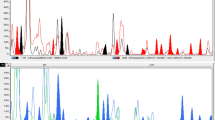Summary
Random genomic probes were used to detect restriction fragment length polymorphisms (RFLPs) in 26 accessions of Musa representing eight species from Papua New Guinea (PNG), M. textilis, M. jackeyi and one accession of Ensete. Ninety-eight phylogenetically informative characters were scored and analyzed cladistically and phenetically. Results generally agreed with previous morphology-based phylogenetic analyses. However, the closest wild relative of the edible M. fehi (fe'i banana) appears to be M. lolodensis. Musa angustigemma is sister species with M. boman and M. jackeyi and is distinct from M. peekelii, with which it is often united. Musa boman is unambiguously placed in section Australimusa. The diploid parthenocarpic landraces of section Musa unique to PNG are closely related to, but apparently distinct from, M. acuminata ssp. banksii. The evolution of the fe'i bananas and the M. acuminata-derived diploid landraces of PNG are discussed.
Similar content being viewed by others
References
Argent GCC (1976) The wild bananas of Papua New Guinea. Notes R Bot Gard Edinburgh 35:77–114.
Baker JG (1893) A synopsis of the genera and species of Musaceae. Ann Bot 7:189–229.
Brewbaker JL, Umali DL (1956) Classification of Philippine Musae I. The genera Musa L. and Ensete Horan. Philipp Agric 40:231–241.
Cheesman EE (1947) Classification of the bananas. II. The genus Musa L. Kew Bull 2:106–117.
Cheesman EE (1949) Classification of the bananas. III. Critical notes on species. Kew Bull 4:445–449.
Cheesman EE (1950) Classification of the bananas. III. Critical notes on species. Kew Bull 4:27–28.
Debener T, Salamini F, Gebhardt C (1990) Phylogeny of wild and cultivated Solanum species based on nuclear restriction fragment length polymorphism (RFLPs). Theor Appl Genet 79:360–368.
Dodds KS (1946) M. fehi, the indigenous banana of Fiji. Nature 157:729–730.
Felsenstein J (1986) PHYLIP (Phylogenetic Inference Package) version 2.9. University of Washington, Pullman, Wash.
Food and Agriculture Organization (1983) Production year book 1983. FAO, Rome.
Gawel N, Jarret RL, Whittemore A (1992) Restriction fragment length polymorphism (RFLP)-based phylogenetic analysis of Musa. Theor Appl Genet (in press).
Havey MJ, Muehlbauer FJ (1989) Variability for restriction fragment lengths phylogenies in lentil. Theor Appl Genet 77:839–843.
Jarret RL (1990) Identification of genetic diversity in the genus Musa. INIBAP, Montpellier.
MacDaniels LH (1947) A study of the Fe'i banana and its distribution with reference to Polynesian migrations. Bernice P Bishop Museum Bull 190, Bishop Museum Press, Honolulu, pp 3–56.
Menancio DI, Hepburn AG, Hymowitz T (1990) Restriction fragment length polymorphism (RFLP) of wild perennial relatives of soybean. Theor Appl Genet 79:235–240.
Miller JC, Tanksley SD (1990) RFLP analysis of phylogenetic relationships and genetic variation in the genus Lycopersicon. Theor Appl Genet 80:437–448.
Murashige T, Skoog F (1962) A revised medium for rapid growth and bioassays with tobacco tissue cultures. Physiol Plant 15:473–497.
Nei M (1972) Genetic distance between populations. Am Nat 106:283–292.
Rhumphius GE (1750) Herbarium Amboinense, 5.
Richardson JM (1957) The fibers of Australimusa in relation to abaca improvement. Trop Agric (Trinidad) 34:207–215.
Rowe PR (1981) Breeding an intractable crop. Bananas. In: Rachie KO, Lyman JM (eds) Genetic engineering for crop improvement. Working Papers, Rockefeller Foundation, pp 66–84.
Sambrook J, Fritsch EF, Maniatis T (1989) Molecular cloning: a laboratory manual. Cold Spring Harbor Press, Cold Spring Harbor, N.Y.
SAS Institute (1988) SAS/STAT user's guide. SAS Institute, Gary, N.C.
Sharrock S (1990) Collecting Musa in Papua New Guinea. In: Jarret RL (ed) Identification of genetic diversity in the genus Musa. INIBAP, Montpellier, France, pp 140–157.
Shepherd K (1990) Observations on Musa taxonomy. In: Jarret RL (ed) Identification of genetic diversity in the genus Musa. INIBAP, Montpellier, France, pp 158–165.
Simmonds NW (1948) Classification of the bananas. III. Critical notes on species. Kew Bull 5:573–574.
Simmonds NW (1956a) Botanical results of the banana collecting expedition 1954–55. Kew Bull 11:463–489.
Simmonds NW (1956b) A banana collecting expedition to South East Asia and the Pacific. Trop Agric (Trinidad) 33:251–271.
Simmonds NW (1959) The bananas. Longmans, Green and Co, London.
Simmonds NW (1962) The evolution of the bananas. John Wiley and Sons, New York.
Simmonds NW, Weatherup ST (1990) Numerical taxonomy of the wild bananas (Musa). New Phytol 115:567–571.
Song KM, Osborn TC, Williams PH (1988) Brassica taxonomy based on nuclear restriction fragment length polymorphisms. Theor Appl Genet 76:593–600.
Southern E (1975) Detection of specific sequences among DNA fragments separated by gel electrophoresis. J Mol Biol 98:302–312.
Swofford DL (1985) PAUP-Phylogenetic analysis using parsimony, version 4.2. Illinois Natural History Survey, Champaign, Ill.
Swofford DL, R Sclander (1989) Biosys-1. Illinois Natural History Survey, Champaign, Ill.
Tezenas du Montcel H (1990) Musa acuminata subspecies banksii: status and diversity. In: Jarret RL (ed) Identification of genetic diversity in the genus Musa. INIBAP, Montpellier, France, pp 211–218.
Author information
Authors and Affiliations
Additional information
Communicated by J. Beckmann
Rights and permissions
About this article
Cite this article
Jarret, R.L., Gawel, N., Whittemore, A. et al. RFLP-based phylogeny of Musa species in Papua New Guinea. Theoret. Appl. Genetics 84, 579–584 (1992). https://doi.org/10.1007/BF00224155
Received:
Accepted:
Issue Date:
DOI: https://doi.org/10.1007/BF00224155




